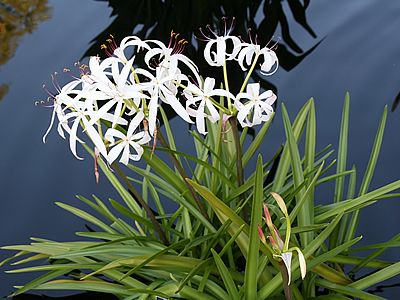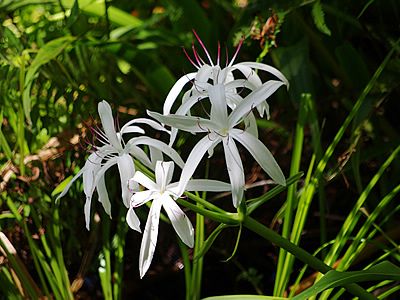The Florida Swamp Lily (Crinum americanum) is a bulbous and flowering species native to swampy regions in the Southwest of the United States, Mexico, and Central America. It grows from substantial bulbs connected by a strong rhizome, thus forming large clumps. Each bulb produces a set of wide, fleshy, ribbon-like, dark green leaves.
It flowers throughout the year, but most prolifically in spring, summer, and autumn, featuring a tall umbel-type inflorescence rising above the foliage, supported by a strong stem. At the top of the inflorescence, two to seven flowers are arranged as in a bouquet. They are white to slightly pink, with long, thin, recurved petals and pink stamens, giving the ensemble a star-like appearance. The flowers are delicately scented and attract hummingbirds.

If planting the Florida Swamp Lily in your garden, ensure ample space as it tends to form large masses. It’s well-suited for low-lying areas of the land with poor drainage, particularly along the edges of ornamental lakes, where it finds its ideal environment.
It can also be used as a border plant, preferably in a confined space to contain its growth. It adapts to different light conditions, blooming even in dark corridors and winter gardens. It can also be planted in pots and planters.
This plant should be cultivated in full sun, partial shade, or indirect light, in soil rich in organic matter and kept moist or even under a narrow column of water. Being native to swampy and waterlogged regions, this crinum thrives in saturated soils, developing best under these conditions. During intense winter cold, its leaves may be damaged, but it vigorously regrows in the following spring.
It tolerates low light conditions, making it a good choice for indoor environments. It enjoys tropical heat and humidity. Unlike many bulbous plants, this species does not favor bulb removal in winter, as it suffers when its roots are damaged, potentially halting flowering for about two years until it readjusts. Fertilize bimonthly in spring, summer, and autumn. After the last frost, cut off damaged leaves to renew the plant’s foliage. Propagation is through division of clumps or bulbs.

